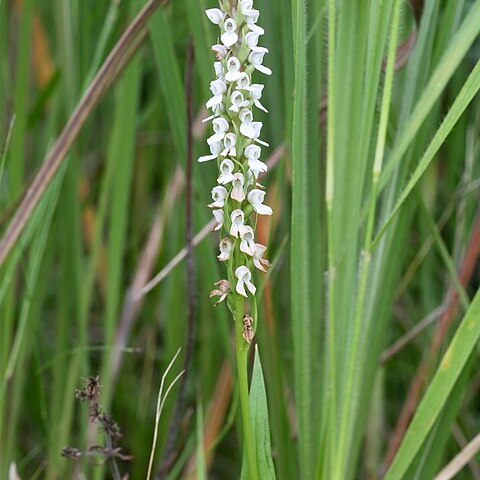Plants 200-600 mm tall; basal sheaths 2, the inner muricate or scabrid, 40-120 mm long; leaves (2-) 3 (-5), blade narrowly lanceolate to rarely lanceolate, semi-erect, very acute to acuminate, basal leaf longest, 80-200 x 8-16 (-25) mm, grading into the floral bracts. Inflorescences slender cylindrical, densely 20-60-flowered, 40-120 mm long. Flowers c. 4 mm in diameter, white with slight green or brown tint. Median sepal galea (2-) 3-5 x 1.5-2 mm and 0.8-1 mm deep; spur soon sharply decurved, frequently clavate, 3-5 mm long; lateral sepals (2-) 3-5 x (1-) 1.5-2.5 mm. Petals oblong to almost square, obliquely acute, nerve falcate. Lip 0.5-1 mm long. Anther c. 0.8 mm long; stigma shortly stipitate, almost horizontal; rostellum c. 1 mm tall.
Terrestrial herb, slender geophyte, 0.2-0.6 m high; with ovoid root tubers. Leaves 2-5, cauline, narrowly lanceolate, up to 150 mm long. Inflorescence a dense, cylindrical spike. Flowers 20-60, small, secund, white, brown after pollination. Sepals unequal; median sepal 2-5 mm long; lateral sepals oblong, 2-5 mm long; spur 3-5 mm long, decurved. Petals oblong to square, small. Lip very small. Flowering time Feb.-Apr.
Herb, up to 0.6 m high. Flowers: in dense to rarely lax, cylindrical spikes, petals not apically expanded, margins not crenulate; spur < 2 x as long as dorsal sepal, sharply decurved; dorsal sepal < 6 mm long; perianth white; Feb.-Apr.
Leaves (2)3(5), grading into the floral bracts, bases sheathing; blades semi-erect, 8–20 cm long, narrowly lanceolate, very acute to acuminate, midrib and often the side-veins prominent beneath.
Terrestrial herb perennating by testicular tubers. Plants erect, 20–60 cm tall, occasionally with fibrous leaf remains around the stem base.
Up to 0.6 m high. Dorsal sepal shorter than 6 mm. Flowers in dense to rarely lax, cylindrical spikes. Spur sharply decurved. Flowers white.
Dorsal sepal galeate; galea (2)3–5 mm tall, 1.5–2 mm wide and 0.8–1 mm deep, ovate, acuminate, falcate in side view.
Rostellum c. 1 mm tall; lateral lobes canaliculate; staminodes almost as tall as the lateral lobes.
Spur horizontal at the base, soon sharply down-curved, 3–5 mm long, cylindric, frequently clavate.
Floral bracts longer than the flowers, narrowly lanceolate to lanceolate, acuminate.
Lateral sepals oblique, (2)3–5 mm long, oblong, acute, the bases frequently fused.
Petals (1.5)2.5–3.5 mm long, oblong to almost square, obliquely acute.
Inflorescence 4–12 cm long, densely 20–60-flowered.
Flowers white with a slight green or brownish tint.
Basal sheath 4–12 cm long, muricate or scabrid.
Lip minute, 0.5–1 mm long.
Stigma almost horizontal.
Ovary 5–10 mm long.
Anther reflexed.

